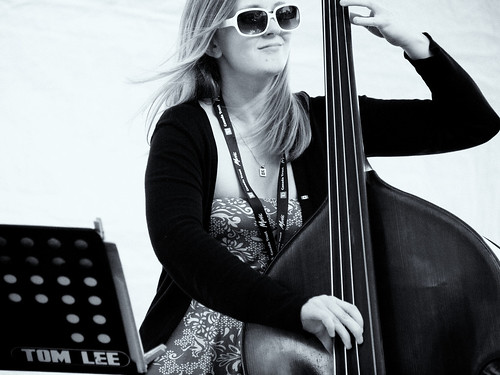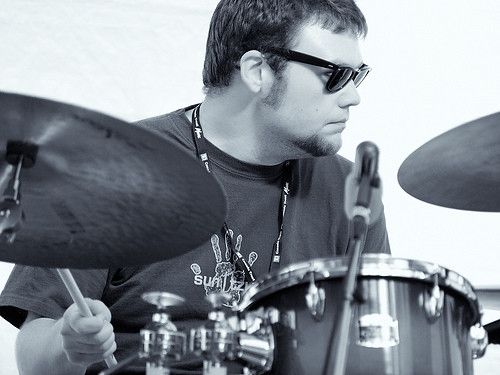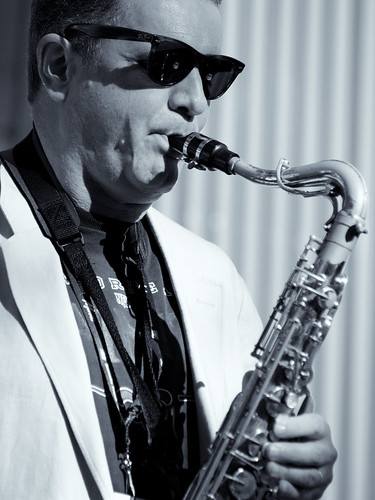Brass Bands.
| Good to be back home. It's fun to go out on the road and play with new people for fresh audiences, but it's also, as Frank Sinatra once famously sang "so nice to come back home." I had a ball in Vancouver playing with my old pal Colleen Savage, and all the folks in her band (drummer Phil Belanger, bassist Dave Guiney, and pianist Brenda Baird) are people I've known and worked with for many years, so that took care of the "old home week " portion of the trip. My gig as a leader, with bassist Jen Hodge (AKA "Hudge Hudgins"), drummer Mike Ardagh and pianist Cat Toren was an opportunity to make new connections with some of the up and coming, gifted young players the city continues to produce in such abundance. Ruminating on this while going through security again *eye roll* at LAX got me to thinking about some of the aspects of the scene in New Orleans that make being a working musician here so different from anywhere else in North America. It's no secret (or shouldn't be) that there's good players everywhere, not just in New York. It's kind of like minor league baseball, there's lots of major league level players in the triple A who are there simply because there's only a certain number of spots in the bigs. Similarly, New York City can only (sort of) support a certain number of jazz musicians; there are plenty of world class players who choose to live in Vancouver or Miami or Cleveland or Kansas City or wherever for all sorts of reasons having nothing to do with ability. The result is it's possible for someone like me to go to pretty much any city in North America and find a first class rhythm section capable of handling the entire canon of straight-ahead jazz at the drop of a downbeat. You can do that in New Orleans too, of course, but there's also a lot of musical situations here that don't really exist anywhere else. There's R&B gigs everywhere (for players of my generation being able to bust out with "Cleo's Mood" and "Honky Tonk," as well as knowing that the bridge to Aretha Franklin's version of "Respect" is the same changes as the one in Sam and Dave's "When Something is Wrong with My Baby" often meant the difference between eating and not eating), but New Orleans has some specific repertorial requirements, like Smoky Johnson's "It Ain't My Fault" and the Meters' "Cissy Strut." There's also some South-Louisiana-specific genres like Cajun music and Zydeco. But the big jobbing-gig thing here, kind of the local equivalent of the wedding band, is the brass band. These can be old-school outfits like the Majestic or Michael White's Liberty Brass Band, which plays traditional repertoire almost exclusively, or bands that play in the more funk-based contemporary style of the Dirty Dozen band, or the Rebirth. Even newer-school outfits like the Hot 8 or the Soul Rebels play a kind of 'brass hop' style of hip-hop, rap music adapted to brass band instruments. There are also more esoteric groups like the Panorama Jazz Band that play hybrids of traditional brass band, early New Orleans jazz, and various Latin and Afro-Cuban styles. The one thing they all have in common is portability, marching capability, and (usually) percussion sections made up of two or more seperate players (one player on bass drum and one on snare). In addition to these relatively fixed-personell outfits there are dozens of 'pick up' type brass bands where who shows up at the gig is related to who's available. My buddy Kevin O'Day, for instance, has a band called the Oakside Brass Band that consists entirely of him on snare and his brother-in-law Frank Lodato on bass drum. When he gets a gig he just starts calling people and you never know who's going to be on the gig. Could be some guy you've never heard of on trumpet, could be the great Kirk Joseph on Sousaphone. Because of the large amounts of Social Aid and Pleasure Clubs in New Orleans (all of whom need at least one band for their annual parade), the persistance of the "jazz funeral" tradition, and the large numbers of other functions which employ these bands (weddings, picnics, political rallies, wine tastings, art gallery openings etc.) there is quite a lot of work for these types of ensembles, and if you're around, competent, and available, sooner or later you'll get called for one of these gigs. What follows are a few pointers for the novice: Music: Needless to say, there ain't no charts. If you're like me, and your knowledge of traditional New Orleans music is rudimentary at best, you'll be relying on your ear to get you through these things initially. The good news is, brass band music, both new school and old, is pretty simple, both melodically and harmonically. Listen to a chorus or two and then sneak in there, you'll probably be cool. The down side of this, for me anyway, is that I now know a whole bunch of tunes I don't know the name of, since nobody ever seems to call anything, one guy just starts playing and everyone joins in. Oh well. The March: Hopefully, you're not so uncoordinated that you can't walk and play at the same time. If you're lucky, you'll get eased into this kind of thing at a "fake" second line of some kind; the art gallery openings and weddings and things that also hire this type of music. At these things the actual 'parade' is usually fairly short, like up and down the block a few times or (a wedding I played a while back) from St. Louis Cathedral to Tipitina's French Quarter location, a distance of about five blocks. But a genuine second line parade for one of the SAPC's, I'm telling you bruh, that march can be a killer, especially in hot weather. Parade permits are issued for four hours. Thank god for bar stops. Attire: Traditional bands require "black and white," meaning white shirt and black pants. The first few of these I did I wore my black wool tuxedo pants. In hot weather this proved to be a tactical error. Black jeans or black cotton summer-weight pants are acceptable to most leaders. Oh, and hats. Ugh. The more casual outfits don't require the traditional five-pointed, visored 'bandsmen's hat', if you're subbing for someone in a band that does, you will be handed someone else's. It will not fit. It will stink. In fact, as my buddy Jim Markway puts it, it will smell "like somebody's old shoe." New school bands generally don't go in for black and whites or hats. As a rule, loose jeans or shorts and oversize t-shirts, either all white or all some other color, are the rule. Sometimes the shirt will have the name of the band on it, sometimes the name of the social club. Or, if it's a funeral, it might be a "memory shirt." These are t-shirts specially made up with the name and photo of the deceased on them, and his dates of birth/death. Sometimes these are rendered as "Sunrise" (date) and "Sunset" (date). If the deceased was a drug dealer or gangster of some kind it will be "Thugged in/ Thugged out." General social issues: As a rule, being the 'new guy' on these things is not that different from any other type of gig, ie. not unlike your first day at kindergarten. Try to make friends and not be a tightass. One big difference though is you get a lot wider range of capabilities than you do on the average jazz gig, everything from self-taught guys who's chop capability begins and ends with "That Old Rugged Cross/Didn't He Ramble" to schooled players who can sight-read fly shit and make any kind of gig. It's not a good idea to jump to conclusions about which is which either. That guy you assume is just a neighborhood bar gnat might be Terence Blanchard's new tenor player. Oh, and if the gig is a straight up second line through the 'hood with a 'new school' funk-style band, you are pretty much guaranteed to be the only white guy around, aside from the Times-Picayune photographer and a few ethnomusicologists doing field studies. You are going to take some teasing about this. Be a good sport and suck it up. And welcome to New Orleans. |




